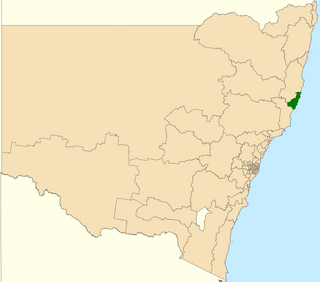Related Research Articles

Port Macquarie is an electoral district of the Legislative Assembly in the Australian state of New South Wales. It is represented by Leslie Williams of the Liberal Party.
Mary Meillon, née Lawson was an Australian politician. She was the Liberal member for Murray in the New South Wales Legislative Assembly from 1973 to 1980.
Peter Maurice King was an Australian politician. He was a National Country Party member of the New South Wales Legislative Assembly from February to August 1981, representing the electorate of Oxley.
Balmain, an electoral district of the Legislative Assembly in the Australian state of New South Wales, has had three incarnations since it was established in 1880. It expanded from 1 to 2 to 3 to 4 members before being abolished in 1894. It was re-established in 1904 returning 1 member until 1920. When multiple member constituencies were established using the Hare-Clark single transferable vote in 1920, Balmain returned 5 members. It had a single member from 1927 when the state returned to single member electorates. It was abolished in 1991 and largely replaced by Port Jackson which included the Sydney CBD. It was re-established in 2007 when Port Jackson was abolished.
Oxley, an electoral district of the Legislative Assembly in the Australian state of New South Wales, was established in 1920, returning 3 members until 1927. It was abolished in 1988 before being reestablished in 1991.
Wollongong, an electoral district of the Legislative Assembly in the Australian state of New South Wales, has had three incarnations, the first from 1904 to 1920, the second from 1927 to 1930, and the third from 1968 to the present.
Lake Macquarie, an electoral district of the Legislative Assembly in the Australian state of New South Wales, has had one incarnation, from 1950 until the present.
Wallsend, an electoral district of the Legislative Assembly in the Australian state of New South Wales, has had four incarnations, the first from 1894 to 1904, the second from 1917 to the 1920, the third from 1927 to 1930, and the fourth from 1968 to the present.
Port Macquarie, an electoral district of the Legislative Assembly in the Australian state of New South Wales, was established in 1988.
Bligh, an electoral district of the Legislative Assembly in the Australian state of New South Wales was created in 1962 and abolished in 2007.
Lachlan, an electoral district of the Legislative Assembly in the Australian state of New South Wales, had four incarnations, from 1859 to 1880, from 1894 to 1920, from 1927 to 1950 and from 1981 to 2007.

Oxley is an electoral district of the Legislative Assembly in the Australian state of New South Wales.
Murray, an electoral district of the Legislative Assembly in the Australian state of New South Wales, has had two incarnations, the first from 1859 to 1999, the second from 2015 to the present.
Castlereagh, an electoral district of the Legislative Assembly in the Australian state of New South Wales had two incarnations, from 1904 until 1920 and from 1927 until 1991.
The 1904 New South Wales state election involved 90 electoral districts returning one member each. The election was conducted on the basis of a simple majority or first-past-the-post voting system. There were two significant changes from the 1901 election, the first was that women were given the right to vote, which saw an increase in the number of enrolled voters from 345,500 in 1901, to 689,490 in 1904. The second was that as a result of the 1903 New South Wales referendum, the number of members of the Legislative Assembly was reduced from 125 to 90. The combined effect of the changes meant that the average number of enrolled voters per electorate went from 2,764, to 7,661, an increase of 277%. Leichhardt was the only district that was not substantially changed, while The Macquarie and The Murray districts retained nothing but the name.
Blayney, an electoral district of the Legislative Assembly in the Australian state of New South Wales was created in 1904 and abolished in 1913.
Broken Hill, an electoral district of the Legislative Assembly in the Australian state of New South Wales has had two incarnations, from 1894 to 1913 and from 1968 to 1999.
Macquarie, until 1910 The Macquarie, an electoral district of the Legislative Assembly in the Australian state of New South Wales, was created in 1894, re-created in 1904, retaining nothing but the name, then abolished in 1920.
Tumut, an electoral district of the Legislative Assembly in the Australian state of New South Wales, was created in 1859 and abolished in 1904.
A by-election was held for the New South Wales Legislative Assembly electorate of Murray on 6 October 1973 because of the death of Joe Lawson (Independent). Lawson had represented the district since 1932, as a member of the Country Party until 1968 when he lost pre-selection. He ran as an independent, winning the seat at the 1968 and 1971 elections.
References
- 1 2 "Mr Bruce Leslie Jeffery (1944- )". Former Members of the Parliament of New South Wales . Retrieved 13 May 2019.
- ↑ Green, Antony. "1973 Murray by-election". New South Wales Election Results 1856-2007. Parliament of New South Wales . Retrieved 22 June 2020.
Green, Antony. "1973 Murray". New South Wales Election Results 1856-2007. Parliament of New South Wales . Retrieved 22 June 2020. - ↑ Green, Antony. "1984 Oxley". New South Wales Election Results 1856-2007. Parliament of New South Wales . Retrieved 26 June 2020.
- ↑ Green, Antony. "1988 Port Macquarie". New South Wales Election Results 1856-2007. Parliament of New South Wales . Retrieved 26 June 2020.
- ↑ Green, Antony. "1991 Oxley". New South Wales Election Results 1856-2007. Parliament of New South Wales . Retrieved 26 June 2020.
- ↑ Green, Antony. "1991 Port Macquarie". New South Wales Election Results 1856-2007. Parliament of New South Wales . Retrieved 26 June 2020.